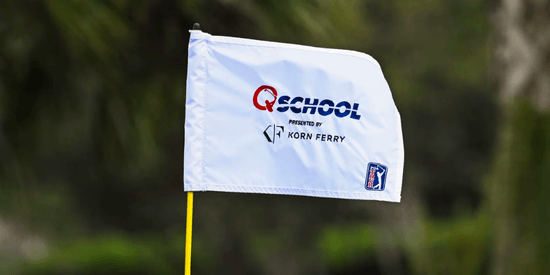Notebook: The NCCGA has plenty of directions to grow
11/18/2018 | by Julie Williams of AmateurGolf.com
see also: NCCGA Fall National Championship, Pinehurst Resort

The NCCGA continues to be a place for college students to stay involved in golf, even if they're not on the varsity team.
Hart, the CEO of Nextgengolf, and his organization are the motor behind the National Collegiate Club Golf Association, which was established in 2006. Nextgengolf is bent on keeping players invested in the game into, through and beyond their 20s, even if they’re not competing at the highest level.
As it grows, the NCCGA becomes a competitive arena for college kids of all abilities, and they’re there for all kinds of reasons.
One need look no further than the leaderboard of the NCCGA Fall National Championship, played Nov. 17-18 at Barefoot Resort in Myrtle Beach, S.C., to see Hart’s message embodied. When winner Ian Martin, a fifth-year senior at Michigan, steps off the plane after a week with his team in Myrtle Beach, he’ll say goodbye to club golf. Martin, who won the individual title with rounds of 67-74, has been offered a spot on the university’s varsity team for his final semester in Ann Arbor. It’s a dream long in the making.
Martin searched for a scholarship opportunity at the Division I or II level out of high school, but still had dreams of studying at the University of Michigan. He gained entry to Michigan after being placed on a wait list, discovered that club golf was an option and tried out as a freshman. He got sick the week of the tryouts and failed to make the team, then transferred to Siena Heights, an Adrian, Mich.-based school that competes at the NAIA level to play golf his sophomore year.Ready for day 1 scoring pic.twitter.com/Q5Wt33ceTm
— NCCGA (@NCCGA) November 17, 2018
Martin thought offers would follow, and when they didn’t, he returned to Michigan to again try out for the club team. This time, he made it.
“It’s just a great group of people, so it was a really easy transition,” said Martin, who says his invitation to join the varsity squad was born of a combination of club golf exposure, a top-10 finish at this summer’s Michigan Open and a 19-shot victory at the Ann Arbor City Championship.
Four spots below Martin on the Myrtle Beach leaderboard, junior teammate Phil Lodzinski (69-75) was drawn to the NCCGA for the same reasons – wanting to continue golf after high school – but has different plans post-college. Lodzinski, who aspires to a career in business, loves golf for the escape it provides from school and stress. Club golf helped him form his closest friendships at Michigan.
“I tried out in the fall of my freshman year, and a lot of the people I met that fall are still some of my best friends,” he said. “Now I’m one of the guys who is running the team, so it’s been a nice progression.”
There are 37 players – including both men and women – on Michigan’s club team, and the average player will get to the course one or two times per week, depending on other commitments. Some club teams have dozens more players, while others have just a few. Players can compete individually if a club team doesn’t have enough individuals to field a team. NCCGA competitions are a unique play-eight-count-five format.
Players from 43 teams as well as 21 individual competitors made up the 352-person combined field for the NCCGA’s National Championship and National Invitational at Barefoot Resort. Each semester includes two regional competitions for the 28 regions around the country and a season-ending national championship. It has been a consistent model since the NCCGA fell under the NextGen wing in 2012, but the reach is growing steadily. There were 30-some teams then, now there’s more than 400 colleges and universities that offer club golf.Shots and sounds from Round 1 #clubgolf pic.twitter.com/MKhqTdQJno
— NCCGA (@NCCGA) November 18, 2018
It’s a good way for varsity coaches to keep an eye on potential talent, and there are plenty of crossover stories like Martin’s.
“It’s like a JV team, without calling it a JV team,” Hart said.
The NCCGA’s story is no longer a get-to-know-us tale. Now, it’s about growth. This is an organization that has arms in all corners of the golf market. Essentially, Nextgengolf is focused on every faction of golfer outside of professionals. It serves the players who buy equipment, pay green fees, belong to clubs and play tournaments.
The NCCGA has hit several milestones as it expands in different directions. Last spring, the national championship was played at Norwood Hills Country Club, a private 36-hole facility that five months later hosted the U.S. Women’s Mid-Amateur. Hart has found that other facilities have used NCCGA hosting responsibilities as a stepping stone to getting an NCAA championship.
“A lot of kids kept graduating and saying, ‘This is awesome, thanks for what you did in college. I’m 22, in Boston or New York or Atlanta, and what do I do now?’” Hart said.
The City Tour operates on a similar model as the NCCGA in 14 major cities, and Hart expects it to keep growing.
Last year, Nextgengolf also launched the National High School Golf Association, and will host its first High School Golf National Championship in June 2019.
Nextgengolf’s mission allows for just as much networking as golf, and NCCGA alum Grant Johnson can speak to that. Johnson, 22, played four years of club golf at the University of Maryland, also serving as president of the NCCGA in 2016.
Johnson now works as a marketing associate for Billy Casper Golf just outside Washington D.C., and plays City Tour golf. He also still volunteers with the NCCGA.
“Club golf really provided the opportunity that I was pretty unsure that I would have going into college,” Johnson said. “Golf really meant a lot to me. I was a little nervous about the idea of losing that opportunity. … For a lot of players it is becoming a realistic option to choose club golf over Division II or III. For me, it was perfect.”
• • •
SIGN ON THE DOTTED LINE
The early signing period for national letters of intent opened on Nov. 14, and junior golfers around the country made their college-golf commitments official. Among the notable commits-turned-signees:
-Florida: Ricky Castillo, U.S. Junior Ryder Cupper
-Oklahoma State: Turner Hosch, organizer of AJGA/Hurricane Harvey fundraiser
-Pepperdine: William Mouw, top-10 finishes in U.S. Am stroke play, Thunderbird Jr, Rolex TOC
-Duke: Erica Shepherd, 2017 U.S. Girls’ Junior champion
-Georgia: Celeste Dao, Canadian Junior Girls champion
-UCLA: Ty Akabane, California Women’s Amateur champion
• • •
TOURNAMENT WE’RE WATCHING: Sun Bowl Marathon All-America Golf Classic
• • •
TWEET OF THE WEEK: Looking back at #linksatpetcopark The annual nine-hole golf experience inside Petco Park, home of the San Diego Padres, ended last week. We thought it was worth a look back:
Beers 🍻
— Callaway Golf (@CallawayGolf) November 9, 2018
Birdies 🏌️♂️
Goat Yoga? 🐐🧘♀️
Every year, #TheLinksAtPetco gets bigger and better. Just ask @XSchauffele 👍 pic.twitter.com/42Oz8ZEw0H
FIVE QUESTIONS WITH…Michael Wice, manager of GHIN services and IT for the Massachusetts Golf Association. Like many cold-weather states, Massachusetts observes an inactive handicap season from Nov. 15-April 1. Wice explained what that means for golfers.
1. What is the purpose behind the inactive handicap season?
For states that have a pretty big climate change between spring/summer and into fall and winter, the inactive season was created to give a stop date for when scores get posted to GHIN for use for your handicap index. The reason for that is up here, courses don’t always maintain the same level of difficulty after a certain point. The rough gets cut down pretty low, the courses are very wet usually, the greens are much higher so the speeds are slower and there’s no leaves on the trees, so trees that may normally post a pretty big obstacle aren’t as hard to get around. The ideas was that if you’ve rated a course for normal playing conditions, you get to a certain point in the season and those playing conditions are no longer normal. So that’s what the inactive season was put into place, to say, ‘OK, at this point in time, the courses are not effectively rated properly.’
2. Is the inactive season the same for all cold-weather states?
It’s different for every cold-weather state. Missouri is different from Massachusetts. Massachusetts is different from Maine. It’s actually different in Southern Nevada from Northern Nevada. It’s not universal across the country. Typically, it’s decided by the state or regional golf association what the active season is going to be in that state. You do consult with other states – we wouldn’t have Rhode Island having their active season end Oct. 30 and us go to Dec. 1. That would not make a ton of sense. There is some collaboration between neighboring states, but it is set by each state itself, what their inactive season is going to be.
3. Besides talking to other states, what other feedback do you search for and whose job is it to truly set the season? Could it ever be changed?Day 2 of the inactive season. The struggle is real, but the thought of brighter days ahead is getting us through these tough times. https://t.co/1lzUfSRIF0
— #MassGolf (@PlayMassGolf) November 17, 2018
There is always a chance that it does change. For many years in Massachusetts, it was Nov. 1 was the last day you could post scores. Within the last five to 10 years it has gone to Nov. 15, so yes there is always the option to change it, but a lot of times it is coordination with your neighboring associations, and also just a general feel that you have form golfers. How often are they playing? Talk to golf course superintendents to say, ‘What kind of conditions are you guys experiencing out there?’ It is hard because here in Massachusetts, Northwest Massachusetts is covered in mountains and gets colder sooner and then we have Cape Cod right on the ocean, you could have people playing until January or February at certain times so there’s no one specific thing we decide, but there are a lot of data points that we take based on what the course conditions of the state are, how many people are actually playing golf, what the difficulty level of the courses are and that’s where we make our decision.
4. Being the handicap guy in a northern association, what is your day-to-day, and what do you do in the inactive season?
Day-to-day is answering any question from across the state, from clubs, from handicap chair-people, from golfers themselves on anything that is GHIN related or any sort of IT program that we service across the state. We do have a tournament management program that we also do maintenance on and help out clubs with. . . . A lot of times with GHIN, it’s usually just why is my handicap this, how do I establish a handicap index? . . . Literally it can be anything across the board. During the offseason, if there’s anything new coming out from the USGA, I have to get ready for that and that’s one of my big plans this offseason, is preparing for new GHIN products that may be coming out soon. The other thing is we do seminars across the on GHIN from time-to-time, so there’s an education component in the offseason.
5. What is the No. 1 question you get about the inactive season, or something you’d like golfers to know?
It’s two parts, one is if it’s a nice day, go ahead and play golf in the inactive season. Just remember that when you play golf in the inactive season in Massachusetts, you can’t post a score for handicap purposes. The second thing would be, if you’re fortunate enough to go down to Florida or California or Texas and you get to play golf, their active season is year-round, so just because we’re inactive here doesn’t mean you shouldn’t post that score.
Most Popular Articles

2025 PGA TOUR Q-School Guide: Sites, Scores, and Who Advanced
Dec 5, 2025Second Stage is complete and Final Stage awaits at Sawgrass — follow every Q-School leaderboard and the players still chasing
2025 LPGA TOUR Q-Series: Final Qualifying Stage FINAL SCORING
Dec 8, 2025Helen Briem earns medalist honors, 31 players headed to the LPGA next year
Australian Open at Royal Melbourne: Preview, amateur bios, and how to watch
Nov 30, 2025Rory McIlroy headlines one of the championship's top fields in years - at least four amateurs will have their chance at glory
Luke Ringkamp Cruises to Rolex Tournament of Champions Title at TPC San Antonio
Nov 26, 2025One week after committing to Pepperdine, Luke Ringkamp won the Rolex Tournament of Champions by nine shots.Inside Gil Hanse’s Restoration of Baltusrol’s Upper Course: A Return to Tillinghast’s
Dec 11, 2025Renowned architect Gil Hanse reveals how he brought Baltusrol’s Upper Course back to life by honoring A.W. Tillinghast’s originalLoading latest news...
